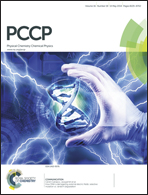How does the dehydration change the host–guest association under homogeneous and heterogeneous conditions?
Abstract
In this study, the thermodynamic properties of association of some inorganic ions (ClO4− and SO42−) with β-cyclodextrins (β-CD) in aqueous solution are determined under both free β-CD and surface confined β-CD conditions using atomistic simulations. The potential of mean force (PMF) is calculated as a function of the environment and the thermodynamic properties of association are deduced by integrating the free energy profiles. No inclusion complex between SO42− and β-CD is detected. Nevertheless, the PMF curve obtained for gold-confined CD seems to evidence a small minimum at a larger separation distance that shows specific interactions such as hydrogen bonding outside the cavity. As concerns ClO4−, our simulations reveal the formation of an inclusion complex with free β-CD in perfect agreement with the available experimental results. Nevertheless, we do not detect any formation of the host–guest inclusion complex under heterogeneous conditions. Finally, the differences observed as a function of the anions are interpreted through an atomistic description. The general trend of weaker complex stabilities with the increasing free energy of hydration of the anions is found in homogeneous systems.


 Please wait while we load your content...
Please wait while we load your content...